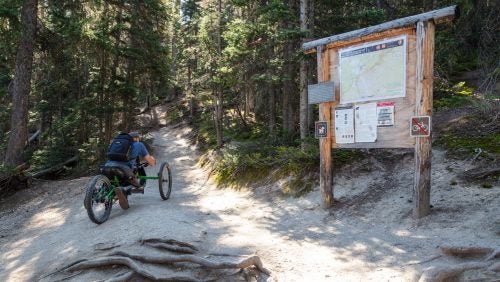Disability Justice and the Environment: Ensuring Equal Access to Nature
January 25, 2024 by Zak Handler

A hiker in a wheelchair takes to a trail in Yellowstone National Park. (Source: Yellowstone National Park, Flickr, https://flic.kr/p/283wvkb)
Access to nature is tremendously important to human health and wellbeing; however, it is not equitably distributed. This post examines the law governing disability access to public lands and offers suggestions for improving access.
Nature and green spaces provide several benefits to health and wellbeing, including mitigating air pollution, reducing urban heat, lowering stress, and facilitating physical activity.[1] These benefits, however, are not readily accessible to everyone. The Environmental Justice movement has drawn attention to how environmental goods, such as public lands, are not distributed equally, and reflect various types of social division such as along racial and class lines.[2] Disability is another type of division affecting access to nature. People with disabilities are less likely to live near public green spaces than are able-bodied people. In addition, disabled people face numerous access barriers.
Public lands and parks are subject to the Americans with Disabilities Act (ADA) and the Rehabilitation Act, which govern federal facilities, including National Parks.[3] If an area is open to the public, it is required to be made accessible unless accessibility measures would conflict with certain environmental policies.[4] Examples of accessibility measures include widening trails, posting tactile maps, and training park staff in disability awareness.
While the law mandates equal access to public lands, litigation has sometimes been necessary to ensure full compliance with the law. In 1998 and 1999, joint class action lawsuits were filed against the California Department of State Parks alleging widespread violations of the ADA.[5] A settlement was reached in 2005, with $100 million to be spent over eleven years in improving accessibility. Just last year in 2023, a blind Californian was granted $2 million in a settlement with the website designers for the California Department of State Parks, whom he alleged had failed to make the Parks website accessible to the blind.[6]
Disability access is not just about National and State Parks. The availability of green spaces near disabled people needs to also be addressed. A study in San Diego found that census tracts with the lowest decile of disability were 15% more likely to live within 0.5 miles of green spaces than were census tracts with the highest decile of disability.[7] Compounding this problem, disability is also correlated with lower socioeconomic status. Disabled people are less likely to own a car or an air conditioner and thus have a greater need for green spaces closer to them.[8]
What should governments do to address these problems? The largest solution is simple: more funding. Increased funding should be allocated to creating new parks in areas with a high number of disabled individuals, improving the accessibility of existing public lands, and investing in new technology and techniques for improving accessibility. While governments have complained that the cost of accessibility can be high, the National Parks Service has found that improving access can also improve revenue, as it attracts more people with disabilities and their families.[9] Disability justice also requires a shift in perspective. Park agencies need to recognize that disabled people want to and can get out into nature. They only need governments to provide reasonable accommodations.
[1] See Silke Schmidt, Preparing for Extreme Heat: Are Cooling Outdoor Spaces Accessible by People with Disabilities?, 131 Environmental Health Perspectives 074002-1 (2023); Qing Li, The Secret Power of the Forest: from a Feeling to a Science, in Nature Is A Human Right: Why We’re Fighting for Green in a Gray World 37 (Ellen Miles, ed. 2022); Jinwon Kima et al., Visualizing fairness: distributional equity of urban green spaces for marginalized groups, 65 J. Environmental Planning and Management 833 (2022).
[2] Duhui Lee et al., Measuring Beach Accessibility for People with Ambulatory Difficulty, 38 J. Park and Recreation Administration 106, 121 (2020).
[3] Laws and Policy, National Park Service (Jan. 7, 2022), https://www.nps.gov/subjects/accessibility/laws-and-policy.htm.
[4] Ellen Aubrey Fred, Outdoor Accessibility Requirements of the Americans with Disabilities Act: Must Holders of Conservation Easements Provide ADA Access, 54 Hastings L.J. 243, 261-64 (2002).
[5] Kelly St. John, State parks to improve access for disabled / Decision resolves 2 class-action suits, SFGate (July 13, 2005), https://www.sfgate.com/news/article/state-parks-to-improve-access-for-disabled-2655605.php.
[6] Kristopher Nelson, BLIND LEADER WINS $2 MILLION SETTLEMENT OVER INACCESSIBLE CALIFORNIA PARKS WEBSITE, Accessibility News International (Dec. 1, 2023), https://www.accessibilitynewsinternational.com/blind-leader-wins-2-million-settlement-over-inaccessible-california-parks-website/.
[7] Schmidt, supra note 1, at 074002-2.
[8] Id.
[9] All In: Accessibility in the National Park Service, 2015-2020, 6, National Park Service (Aug. 29, 2014), https://www.nps.gov/aboutus/upload/All_In_Accessibility_in_the_NPS_2015-2020_FINAL.pdf.

